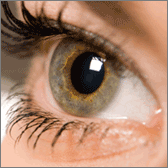
Hyperopia is an inherited condition that occurs when the cornea is too flat or the distance from the cornea to the retina is too short. When this happens, the light rays coming from an object strike the retina before coming to sharp focus, or the image is theoretically focused at an imaginary point behind the retina. The result is a blurred image when trying to focus on something that is up close, but distance vision remains sharp.
Refractive eye surgery, which steepens the cornea, has recently become an option for the correction of farsightedness. The most popular of those procedures is Laser In-Situ Keratomileusis (LASIK), which uses an Excimer laser to reshape the cornea. Other procedures that show promise for the surgical correction of hyperopia include Implantable Contact Lenses (ICLs) that fit between the iris and the natural lens of the eye, and Clear Lens Extraction (CLE) during which the eye's natural lens is replaced by a plastic intraocular prescription lens. Another procedure that shows promise for the treatment of hyperopia is Laser Thermal Keratoplasty (LTK), which uses a Holmium laser to shrink the peripheral area of the cornea in order to steepen the shape. Refractive eye surgery is usually not recommended for people under 18 years of age.